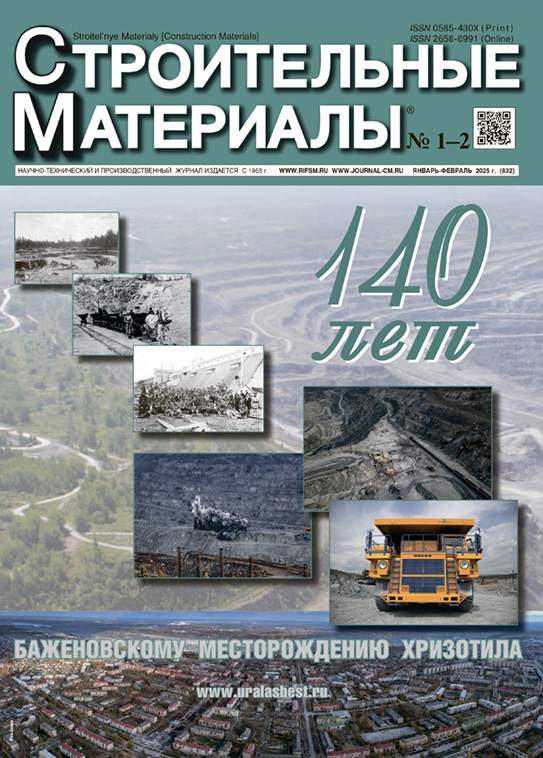Исследование физико-химических и механических свойств композиционных материалов на основе лигносульфонатов
- Авторы: Жуланова А.Е.1, Глушанкова И.С.1
-
Учреждения:
- Пермский национальный исследовательский политехнический университет
- Выпуск: № 1-2 (2025)
- Страницы: 66-71
- Раздел: Статьи
- URL: https://cardiosomatics.ru/0585-430X/article/view/677200
- DOI: https://doi.org/10.31659/0585-430X-2025-832-1-2-66-71
- ID: 677200
Цитировать
Полный текст
Аннотация
Возрастающие темпы строительства в России и повышающиеся экологические требования к строительным материалам приводят к необходимости поиска новых решений для создания уникальных материалов и вовлечения дополнительных ресурсов. Проведенный анализ научно-технической литературы и лабораторные исследования показали, что одним из перспективных источников сырья для производства композиционных строительных материалов могут быть лигносульфонаты. В связи с этим в работе исследован и обоснован способ получения композиционных материалов на основе лигносульфонатов. Установлено, что в полученных композициях лигносульфонаты выполняют роль как отвердителя, так и дисперсного наполнителя. Методом термогравиметрии доказано, что полученные композиции термически устойчивы. Результаты исследования физико-химических и механических свойств полученных образцов показали, что лигноэпоксидные композиционные материалы могут быть альтернативной заменой известным промышленным аналогам.
Полный текст
Об авторах
А. Е. Жуланова
Пермский национальный исследовательский политехнический университет
Автор, ответственный за переписку.
Email: 79194776224@yandex.ru
Канд. техн. наук
Россия, 614990, г. Пермь, Комсомольский пр-т, 29И. С. Глушанкова
Пермский национальный исследовательский политехнический университет
Email: irina_chem@mail.ru
Д-р техн. наук
Россия, 614990, г. Пермь, Комсомольский пр-т, 29Список литературы
- Damien Breilly, Sami Fadlallah, Vincent Froidevaux, Antoine Colas, Florent Allais. Origin and industrial applications of lignosulfonates with a focus on their use as superplasticizers in concrete. Construction and Building Materials. 2021. Vol. 301. 124065. https://doi.org/10.1016/j.conbuildmat.2021.124065
- Flatt R., Schober I. Understanding the rheology of concrete. Woodhead Publishing Limited. 2012. 364 r.
- Li K., Geng X. Formaldehyde-free wood adhesives from decayed wood. Macromolecular Rapid Communications. 2005. Vol. 26, pp. 529–532. https://doi.org/10.1002/marc.200400594
- Jang Y., Huang J., Li K. A new formaldehyde-free wood adhesive from renewable materials. International Journal Adhesion and Adhesives. 2011. Vol. 31, pp. 754–759.
- Варанкина Г.С., Русаков Д.С., Иванова А.В., Иванов А.М. Снижение токсичности древесных клееных материалов на основе модифицированных лигносульфонатами карбамидоформальдегидных смол // Системы. Методы. Технологии. 2016. № 3. C. 154–160.
- Kim J., Lee J-H., Jeong S., Lim S. Formaldehyde emissions from particle board made with phenol–urea–formaldehyde resin prepared by different synthesis methods. Journal of Adhesion Science and Technology. 2015. Vol. 28. Iss. 19, pp. 2090–2130. https://doi.org/10.1080/01694243.2015.1057394
- Jia L., Chu J., Li J., Ren J., Huang P., Li D. Formaldehyde and VOC emissions from plywood panels bonded with bio-oil phenolic resin. Environmental Pollution. 2020. Vol. 264. 114819. EDN: EGVFJT. https://doi.org/10.1016/j.envpol.2020.114819
- Mirski R., Dukarska D., Derkowski A., Czarnecki R., Dziurka D. By-products of sawmill industry as raw materials for manufacture of chip-sawdust boards. Journal of Building Engineering. 2020. Vol. 32. 101460. EDN: CKVLJC. https://doi.org/10.1016/j.jobe.2020.101460
- Ihnat V., Lübke H., Russ A. Waste agglomerated wood materials as a secondary raw material for chipboards and fiberboards. Part I. Preparation and characterization of wood chips in terms of their reuse. Wood Research. 2017. Vol. 62, pp. 45–56.
- Salthammer T., Mentese, S.; Marutzky, R. Formaldehyde in the Indoor Environment. Chemical Reviews. 2010. Vol. 110, pp. 2536–2572. EDN: YCRWOF. https://doi.org/10.1021/cr800399g
- Amaral C.R., Sanchez Rodriguez R.J., Gonzalez Garcia F., Junior L.P.B., Carvalho E.A. Impact of aliphatic amine comonomers on DGEBA epoxy network properties. Polymer Engineering Science. 2013. Vol. 54. Iss. 9, pp. 2132–2140. https://doi.org/10.1002/pen.23751
- Isikgor Furkan H., Becer C. Remzi. Lignocellulosic biomass: a sustainable platform for the production of bio-based chemicals and polymers. Polymer Chemistry. 2015. Vol. 6. Iss. 25, pp. 4497–4559. EDN: SNDKZE. https://doi.org/10.1039/c5py00263j
- Hong Pan, Gang Sun, Tao Zhao. Synthesis and characterization of aminated lignin. International Journal of Biological Macromolecules. 2013. Vol. 59, pp. 221–226. https://doi.org/10.1016/j.ijbiomac.2013.04.049
- Жуланова А.Е. Использование лигнинсодержащих отходов целлюлозно-бумажной промышленности для получения лигноэпоксидных композиционных материалов // Экология и промышленность России. 2023. Т. 27. № 3. С. 18–23. EDN: LSONUW. https://doi.org/10.18412/1816-0395-2023-3-18-23
- Жуланова А.Е., Глушанкова И.С. Утилизация лигносульфонатов с получением композиционных строительных материалов // Теоретическая и прикладная экология. 2022. № 1. С. 134–139.
Дополнительные файлы













